Perhaps the most colorful and loveable of the traveler trifecta of food, shelter and water is food. Where to get it, how to find it, how much it cost, whether or not it made you sick. These are among every traveler’s tales. But beyond apples, bananas and oranges all over the world you can find people’s favorite fruits that look like something dreamt up by someone with a malaria-induced fever.
The usual warnings apply, peel it, cook it or forget it, but the more intrepid may try their hand washing them well (with clean water) building up a little local intestinal flora, or throwing caution to the wind. Waiting ‘til they show up at your local supermarket is another option. Your tastebuds send thank you notes.
[social]
Below are 15 fabulous fruits you won’t just want to meet and forget, but will want to photograph, savor and take home. Careful on this last one, unless it’s cooked and preserved, many governments prohibit the importation of fresh fruits and veggies by your average traveler.
Pitaya/ dragon fruit
(In the Armericas: Mexico, Central America, South American tropics, especially Ecuador)
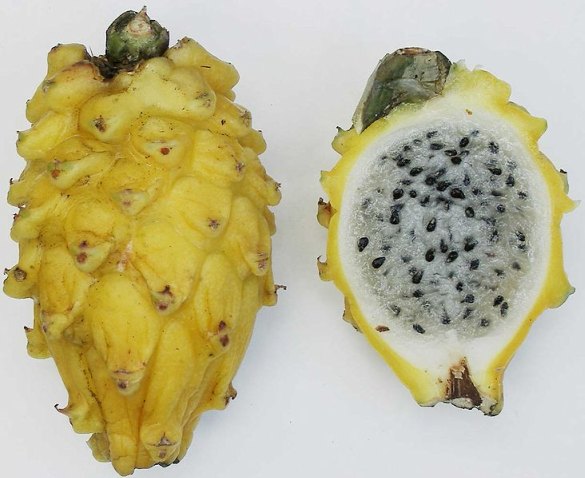
These oblong yellow fruit are not weapons, though you wonder if they could be used as such in a pinch, all yellowish-orangey and covered with unkind spikes. Rather than using one as a mace, buy one at the market, slice it lengthwise and scoop out the grayish pulp flecked with tiny, edible black seeds. The fruit is mildly sweet, but it’s main punch is really it’s appearance. Fire breathing optional.
Açaí (say: a-sigh-EE)
(Mainly Brazil)
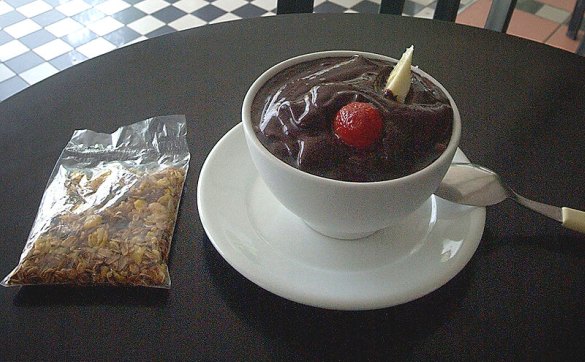
This is a fruit of a Brazilian palm that’s showing up as everyone’s favorite new anti-oxidant containing fruit. It’s a round, dark purple berry that’s sweetened, frozen solid and then mashed up and served along sliced bananas and granola along populated beaches in Brazil as açaí na tigela (açaí in a bowl). It has a strong, almost grape-like flavor, and can also be drunk in its slushier form from a glass, and shows up as a flavoring in other products. The berries can be hard to come by, but the frozen treat can be found all over Brazil, and in some major cities in the US.
Guavas (goiaba, guayaba)
(In the Americas, Mexico, Brazil, the Carribean)
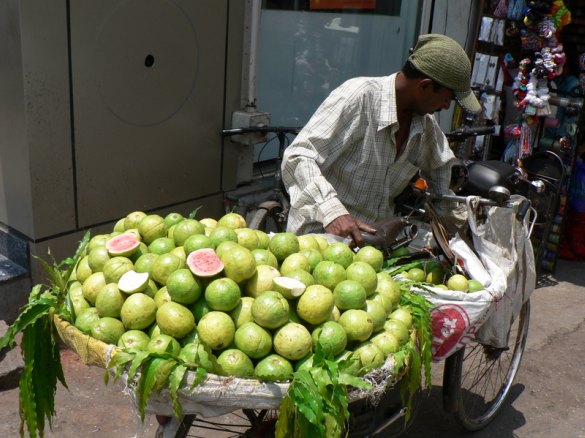
The first time I saw guavas for sale on the street in São Paulo, I thought they were tiny, apple-sized watermelons. This tropical fruit is bumpy green on the outside, a pinkish red inside and smells a bit lemony. Depending on the variety, it can be very high in antioxidants and vitamin C, and most commonly appears on the table boiled into a jelly-like paste on the breakfast table as goiabada or in sweets filled with the same.
Membrillo (Quince)
(In the Americas: Mexico, Chile, temperate zones)

The mutant-apple looking membrillo is usually yellow, has a pronounced bump at the end, and bruises easily, leading to the Chilean expression “mas machucado que un membrillo” (more bruised than a quince). They’re tart, occasionally eaten out of hand with salt, and show up in a sliceable jelly similar to Brazilian goiabada, in this case called dulce de membrillo or simply membrillo.
Tomate de arbol (Tree tomato, tamarillo)
(In the Americas: Guatemala, Honduras, Brazil, Ecuador, Argentina, Colombia, Venezuela, Jamaica, Puerto Rico and Haiti)
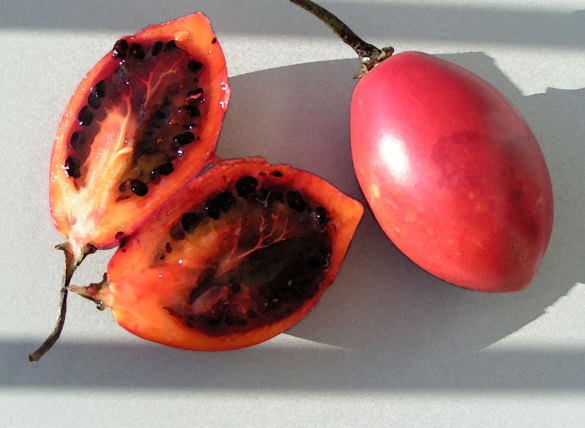
This distant relative of the tomato, also part of the nightshade family, is found in Peru, Chile, Ecuador, Colombia, and Bolivia, and is cultivated in other parts of the world, including New Zealand. It may be orange or yellow in flavor, and oblong in shape with a defined pointed end. It can be eaten raw or cooked with a syrup, and often shows up in juice. The taste is a cross between papaya and a really strong tomato flavor, and the flesh is soft.
Nísperos (loquats, Japanese medlar, ameixa amarela)
(Originally from the SE of China, now in the Americas in: Subtropical areas in Chile, Uruguay, Argentina, Brazil)
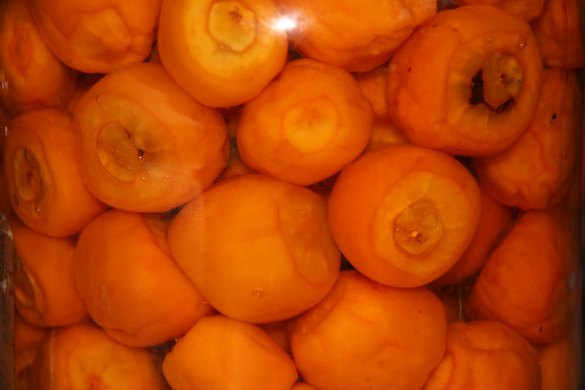
Nisperos are one of the harbingers of spring in the southern hemisphere, and these soft yellowish orange fruits often appear at the market in giant piles with leaves still attached. You can eat the skin or squeeze the flesh out, but either way, eating nisperos is messy business, and one or two seeds are contained in each fig-sized fruit which must be spit into your hand or onto the street. The flavor is mildly sweet, and they can be found jarred in syrup, but purists will prefer theirs fresh.
Physalis (Cape Gooseberry, Chinese Lantern, Colombia: uchuva, Peru: aguaymanto)
(In the Americas: Colombia, Peru)
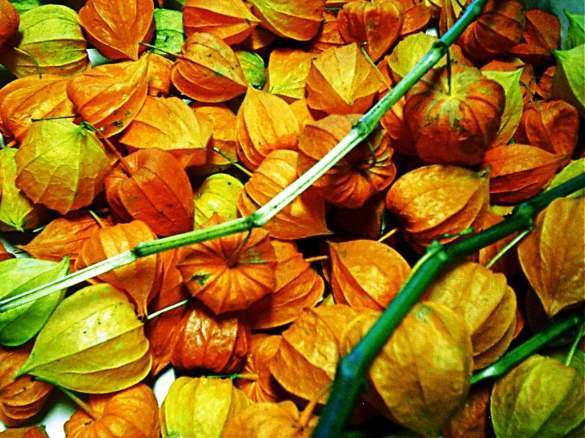
The physalis are another member of the nightshade family, this time hidden inside a papery husk not unlike a tomatillo. Each individual fruit is the size of a small cherry tomato and packs an acidic punch, though the fruit may also be quite sweet. In the summertime, you can find them fresh and eat them out of hand, but they are more also commonly found in a seeded, pulpy preserves of the same name.
Cherimoyas (chirimoya, anona blanca, graviola custard apple)
(In the Americas, Chile, Peru, Ecuador, El Salvador, Belize, Guatemala, Brazil, Haiti)
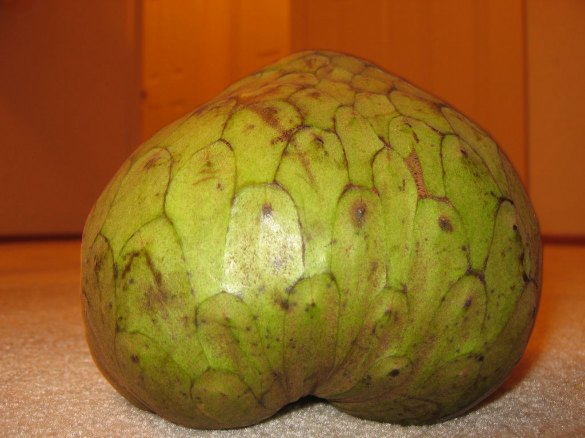
These are a large, lumpy, green fruit that can be heart-shaped or round, and which look vaguely primordial, as though they used to have scales. When you break one open, they have a soft white flesh which give the cherimoya the name it’s known by in much of the Carribean, “custard apple.” It’s dotted with large, oblong brownish-black seeds, which are not eaten. Grab a spoon and enjoy one of these fruits right out of it’s skin for its pearlike flavor with more than a touch of creaminess. It can also be served as part of a punch served with sweet white wine.
Jackfruit (jaca)
(In the Americas, Brazil, Surinam)
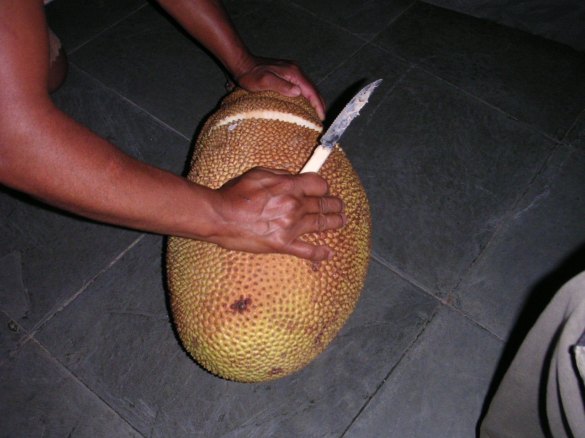
The jackfruit, relative of the breadfruit is originally from India but is cultivated all over the tropics. Large and spiky, one wonders what the discoverers of the fruit thought they might find inside. Breadfruits can be quite large, and they’re rumored to yield enough fruit to feed a village, which is a good warning that you probably don’t want to buy a whole one. The mildy-flavored fruit is sold on the street in little bags, in sections which must be cut from the fruit. Do like the locals do, pop a mildly-sweet, somewhat starchy section in your mouth and spit out the seed.
Passionfruit (maracuyá, grenadilla)
(In the Americas, Brazil, Colombia)
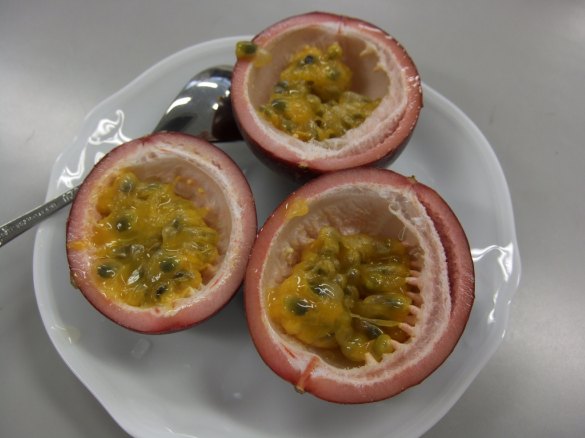
While you’ve probably tasted passionfruit juice, this small fruit’s appearance may surprise you. It can be bumpy and dried-out looking from the outside, and when you cut it open, it reveals a gooey mass of orangeish pulp with green seeds speckling the interior. It’s most commonly enjoyed as a juice, thought it shows up in ice cream from time to time, and sweeter varieties in Colombia may be eaten with a spoon. Its taste is somewhat citrusy but with a heavy dose of something else and a very distinctive smell.
Cashew Fruit (cajú, cashew apple, jocote de marañon)
(In the Americas, Tropical Central and South America)
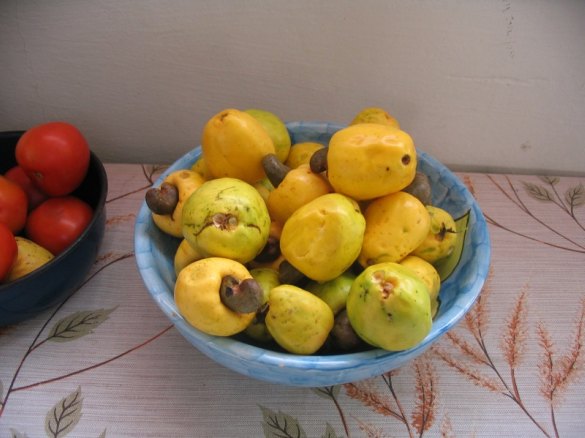
The comma-shaped seed (often mistakenly called a nut) is not the only product that this tropical plant has to offer. Looking like misshapen red or yellow peppers, these astringent-when-not-quite-ripe fruits may show up in your breakfast fruit basket. When they’re ripe, they’re sweet and juicy, and can be eaten out of hand. They also appear as juice on menus all over the north of Brazil.
Prickly pear cactus fruit (tuna, Indian fig)
(In the Americas, Mexico, semi arid areas of South and Central America and the Carribean)
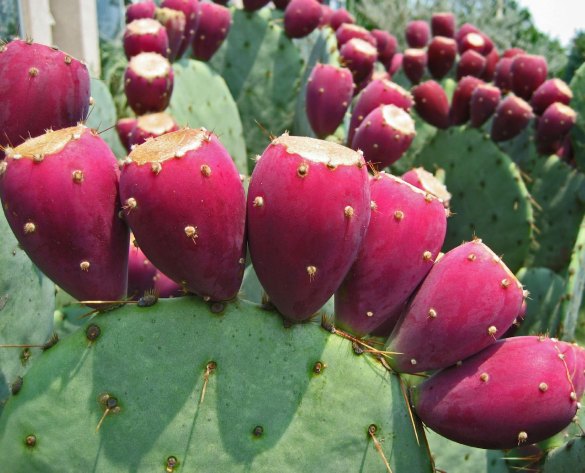
This fruit may look like the un-prickly part of the cactus, but don’t be so sure. These blunt-ended oblong fruit actually have tiny fibrous spines covering their outsides and should be handled gingerly. Slice them lengthwise and scoop out the pulp with one stroke of the spoon, eat and enjoy. The taste is somewhere between a cucumber and honeydew melon, though the seeds will remind you that you’re eating something else. It’s often made into a refreshing juice, and studies indicate that an extract from this plant may ease the symptoms of a hangover, so drink up!
Pepino dulce (lit: sweet cucumber, occasionally called melon pear)
(In the Americas: Colombia, Ecuador, Bolivia, Peru and Chile)

Pepino dulce is so named for its alleged resemblance to a cucumber. The fruit is oblong and has one pointy end, and is often whitish green streaked with purple. They’re peeled and sliced as part of a fruit plate, and taste a bit like a melon when they are ripe and somewhat bitter when they’re not. The flesh is soft, and the seeds you find inside are not eaten.
Starfruit (carambola)
(In the Americas: Trinidad, Guyana, Brazil)
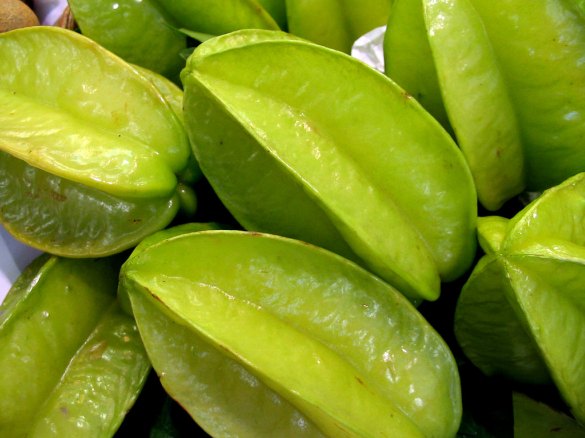
The starfruit is famous for it’s cross-sectioned cut which looks, not surprisingly, like a star. With any luck you may find it growing from a tree about the size of an apple tree. When they’re not quite ripe, they’re very crunchy and taste more like a green apple than you’d expect, but when they’re yellow and give slightly, and in hotter climates, they’re juicy and have a taste is all their own. Look for carambola juice in Brazil, but statin-takers and kidney patients are advised to avoid this fruit due to some of it’s grapefruit-like chemical qualities.
Lulo (naranjilla)
(Colombia, Ecuador)
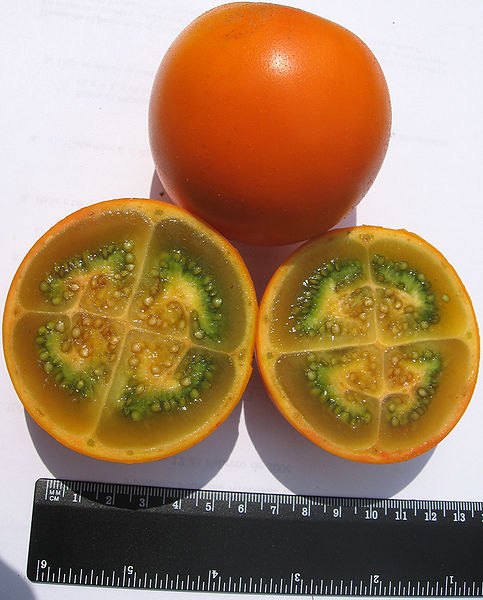
This is a smooth fruit, shaped like a small tomato, of which it is a distant relative. Juice or milkshakes made from this fruit makes many a traveler exclaim, kiwi, no! pineapple, no! mint! no! No indeed, the fruit is lulo (or naranjilla) and it’s found only in Colombia or Ecuador, and usually used to make a refreshing, pale orange-ish brown juice. The fruit is not eaten out of hand, though it often shows up in Ecuador’s national alcoholic beverage (served hot), a potent concoction of the fruit, sugar, sugar cane alcohol (aguardiente) and cinnamon.
Hungry for more? Read more about unusual foods around the world:
- 11 Delicious Streets Foods from Around the World
- A Dish for All Seasons: What to Eat (and When)
- Exciting Edibles in South America
- The Many Weird Fruits of Southeast Asia
Read about author Eileen Smith and check out her other BootsnAll articles
Photo credits:
Pitaya, Acai, Guavas, Membrillos, Tomate Arbol, Nisperos, Physalis, Cherimoyas, Jackfruit, Passion fruit, Cashew Fruit, Prickly Pear, Pepino Dulce, Star fruit